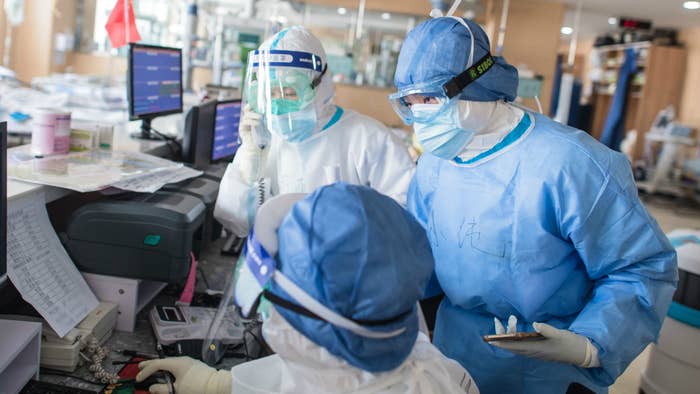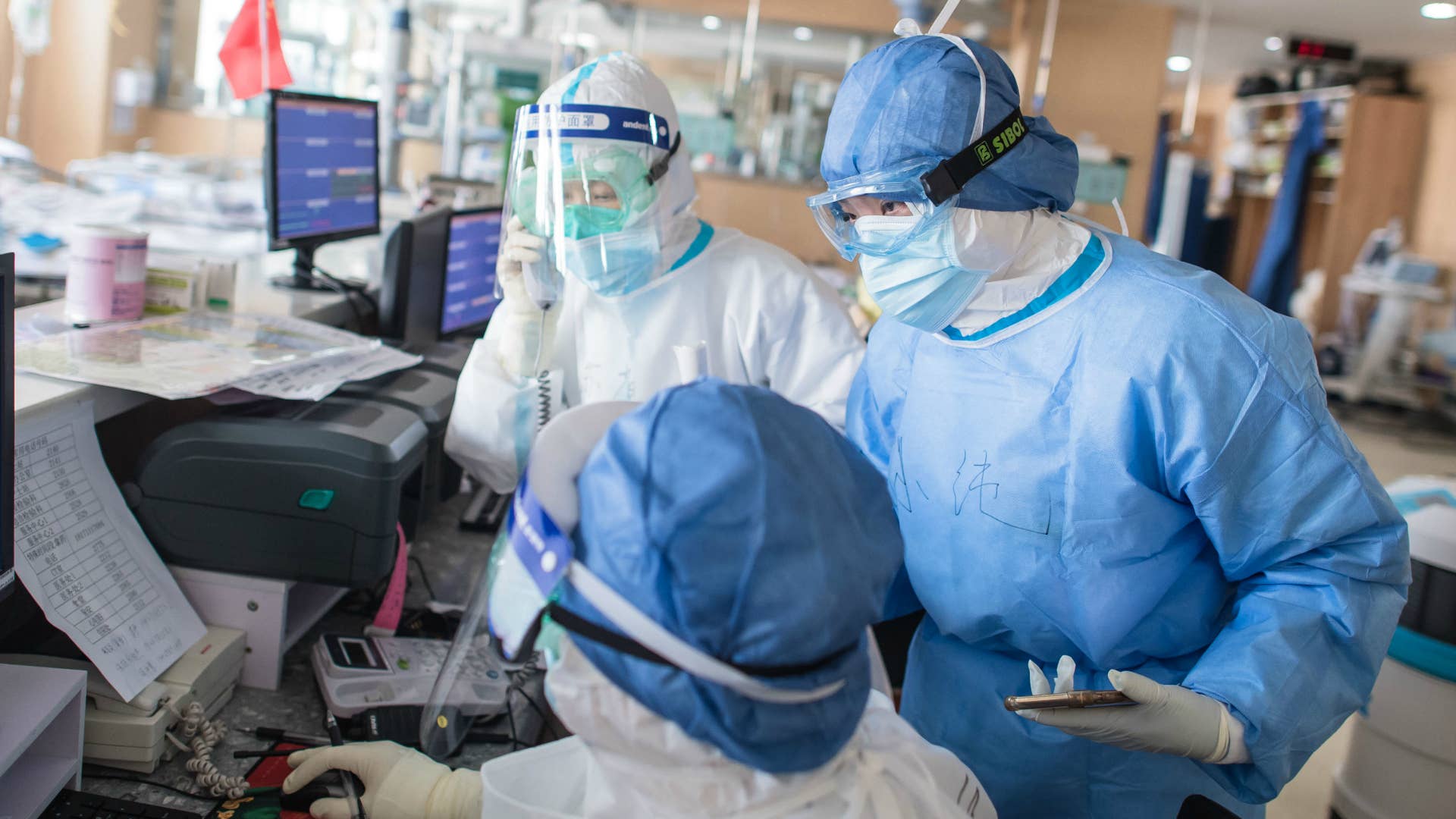
The United States now has the most coronavirus-related deaths in the world. As of April 11, the United States is now reporting at least 18,860 deaths due to the virus, per Johns Hopkins University. This pushes the U.S. past Italy, where 18,849 have died from the illness.
The US also has recorded over half a million confirmed cases of the coronavirus.
The deadly novel coronavirus, which has now claimed over 7,000 lives worldwide and infected more than 179,000 people as of midday March 16, was recently officially declared a pandemic by the World Health Organization.
At least 162 countries and territories have been impacted. The death toll for the virus eclipsed that of the severe acute respiratory syndrome (SARS) outbreak in 2002. At the time of this writing, at least 4,100 U.S.-based cases of the virus have been reported. The death toll in the U.S. as of March 16 is 71, at least 42 of whom passed in Washington state. All 50 states in the U.S. have reported cases. West Virginia was the last state in the country to have confirmed a case.
Also as of midday March 16, at least 375 people in Canada have been diagnosed, with one death. The most highly affected nations are China (80,880 cases, 3,213 deaths), Italy (27,980 cases, 2,158 deaths), Iran (14,991 cases, 853 deaths), Spain (9,428 cases, 335 deaths), and South Korea (8,236 cases, 75 deaths). Here's a continuously updated resource for those numbers.
New York City Mayor Bill de Blasio declared a state of emergency on March 12, saying more than 1,700 people have voluntarily quarantined themselves.
New York state has at least 746 cases of the virus as of March 16; the first COVID-19 death in NYC was confirmed on March 14. An 82-year-old woman, who went to the hospital on March 3, died after contracting the virus.
Shortly after, officials in Rockland County reported that a 65-year-old man from Suffern, New York had died of COVID-19 on Thursday, as reported by The Daily Beast.
Gov. Andrew Cuomo revealed on March 15 that two New York state lawmakers tested positive for coronavirus.
Gov. Cuomo confirmed a third death related to coronavirus, a 79-year-old woman who passed away in the New York state, as reported by the New York Post.
Three patients who contracted coronavirus in Maryland have fully recovered, however, and have since been given to go-ahead to return to life as normal.
On March 16, WHO said it has shipped nearly 1.5 million tests to 120 countries.
According to the New York Times, the Centers for Disease Control and Prevention built four statistical models that projected how the deadly virus could affect the nation. The modeling is intended to help health systems and various other entities prepare for a surge of infected patients. The Times reports that one of the scenarios projects 160 million and 214 million U.S. citizens would be infected with coronavirus throughout the pandemic; of those cases, between 200,000 to 1.7 million could end in death, based on hospital capacity and mortality data at that time.
Per the report:
And, the calculations based on the C.D.C.’s scenarios suggested, 2.4 million to 21 million people in the United States could require hospitalization, potentially crushing the nation’s medical system, which has only about 925,000 staffed hospital beds. Fewer than a tenth of those are for people who are critically ill.
On Friday, March 6, UCLA released a statement saying three students were being tested for the virus. "We learned tonight that three UCLA students are being tested for COVID-19 by the Los Angeles County Department of Public Health (LACDPH)," Chancellor Block wrote in the statement. "All three students are self-isolating off campus." According to the California Department of Public Health, the state has 60 positive cases of the virus and one death. After a lawyer who works in Midtown Manhattan became New York's second case, more cases have emerged.
The lawyer's family and his neighbor have also tested positive for coronavirus, NBC New York reports. Manhattan's Yeshiva University, where the son studies, canceled all in-person graduate courses. The daughter attends SAR Academy and High School in the Bronx, which has also been shut down. There are now a total of 13 cases in New York state, after a man in his 40s and a woman in her 80s tested positive for the virus. Neither had any connection to travel or other COVID-19 patients, which hints to fresh community spread in New York City.
On March 5, Tennessee Gov. Bill Lee confirmed the first case of the coronavirus in the state of Tennessee.
It was reported that the first person in Rhode Island tested positive for coronavirus after visiting Italy while in Manhattan, a woman confirmed New York's first case after returning from Iran.
On Wednesday, March 4, New Jersey announced the state's "first presumptive positive case of novel coronavirus."
Tonight, Acting Governor @LtGovOliver and I are announcing the first presumptive positive case of novel coronavirus, or #COVID19, in New Jersey. The individual, a male in his 30s, is hospitalized in Bergen County and has been hospitalized since March 3rd. pic.twitter.com/E2QtB1Wzut
On March 2, the U.S. Surgeon General warned people to stop wasting their efforts buying surgical masks, tweeting, "They are NOT effective in preventing general public from catching #Coronavirus, but if healthcare providers can’t get them to care for sick patients, it puts them and our communities at risk!"
The virus has caused closures over infection fears. Notably, France's Louvre Museum was closed, a music festival in Indonesia was canceled, and there's currently a petition with more than 15,000 signatures calling for the cancellation of SXSW. Twitter pulled out of SXSW over coronavirus concerns, which means CEO Jack Dorsey’s planned keynote has been canceled too. Eventually, SXSW was called off completely as a result of the virus.
On Feb. 26, health officials in Nassau County, New York, announced they were monitoring 83 residents who were potentially exposed to the virus. The individuals agreed to be quarantined for two weeks, beginning from the date they were last in China or had contact with someone who was infected with coronavirus.
"We check in with them every day for their temperature," Nassau County Health Commissioner Lawrence Eisenstein told reporters Wednesday. "We deliver a thermometer to them if they don't have one handy. We take care of making sure they do that. They are in communicating with us and we are communicating with them."
Also on that day, the CDC confirmed the possibility of a person from California contracting the virus by community spread, the New York Timesreported. The person is said to have not traveled to any country in which the virus is present or been exposed to anyone who has the virus.
"At this point, the patient’s exposure is unknown," the CDC said in a statement, per NYT. "The case was detected through the U.S. public health system and picked up by astute clinicians."
Since then, six more people have contracted the virus in Los Angeles County, leading officials to declare a state of emergency, the Hollywood Reporter reports. The county total is now at seven.
.@VP will lead the Administration's efforts to protect the American people from the spread of coronavirus. pic.twitter.com/09n5erHaHP
In a move that was criticized, President Donald Trump, not heeding calls to appoint an outside expert, has put Vice President Mike Pence in charge of a task force to stop the spread of the coronavirus. Indiana's Scott County saw an HIV outbreak while Pence was governor. Public health experts have said the outbreak, which impacted around 200 people, was preventable.
When person-to-person spread has occurred with MERS and SARS, it is thought to have happened mainly via respiratory droplets produced when an infected person coughs or sneezes, similar to how influenza and other respiratory pathogens spread
On March 2, Twitter told its staff that "all employees globally" are encouraged to work from home. "Our goal is to lower the probability of the spread of the COVID-19 coronavirus for us–and the world around us," the message states.
As international concern surrounding the virus continues to rise, we take a look below at how this all started and what's currently being done in an effort to prevent further spreading of the resulting infection that's now being said to potentially be "much more contagious" than initially believed.
What is the coronavirus?
The Centers for Disease Control and Prevention (CDC) says the 2019 novel coronavirus (2019-nCoV) is a virus "identified as the cause of an outbreak of respiratory illness first detected in Wuhan, China."
Many of the initial patients in the Wuhan outbreak had signs suggesting an animal-to-person spread, though subsequent patients have had no such exposure. This indicates a person-to-person spread, says the CDC, who added in their rundown on the coronavirus that they've determined it's still "unclear how easily or sustainably" the virus is spreading.
Symptoms can include fever, cough, and shortness of breath. The symptoms may start to manifest within as little as two days (or as far out as 14 days) from exposure.
How does it spread?
As touched on above, this virus is widely believed to have started via animal-to-person transmission, though that has since grown to person-to-person. The CDC says person-to-person spreading can occur "on a continuum," adding that it's still not clear how easily 2019-nCoV can be spread in this manner:
Health officials have confirmed an estimated 81,027 cases of the virus worldwide, with the current death toll at 2,764. On Wednesday, WHO Director-General Tedros Adhanom Ghebreyesus announced the virus had spread to 37 countries, with a total of 2,790 confirmed coronavirus cases and 44 deaths outside of China.
"Yesterday, the number of new cases reported outside China exceeded the number of new cases in China for the first time," Ghebreyesus said. "The sudden increases of cases in Italy, the Islamic Republic of Iran and the Republic of Korea are deeply concerning. There are now cases linked to Iran in Bahrain, Iraq, Kuwait and Oman. There are now cases linked to Italy in Algeria, Austria, Croatia, Germany, Spain and Switzerland."
Li Wenliang, described by CNN as "the Chinese whistleblower doctor" who first warned of a possible "SARS-like" disease late last year, was reported in February to have died of coronavirus in Wuhan.
Unfortunately, some online have taken fast to xenophobic or otherwise offensive comments about foreign delicacies as the coronavirus story takes shape. As the Daily Dotnoted this week, Chinese blogger Wang Mengyun recently issued an apology for eating a bat in a 2016-era video that has since resurfaced. She also pointed out that the clip in question was not filmed in Wuhan.
On Wednesday, March 12, the WHO announced that dogs cannot contract the coronavirus.
How have political leaders and others reacted?
The U.S., France, and other countries are actively attempting to get their citizens out of Wuhan, where only specially permitted vehicles are currently allowed. This week, Trump—who, unfortunately, remains the POTUS—said his administration had been in "close communication" with officials in China. Furthermore, Trump said via Twitter, the U.S. is "strongly on watch" with experts he deemed "extraordinary."
However, as Vin Gupta (an assistant professor of pulmonary and critical care medicine at the University of Washington) explained in a recent NBC Newsop-ed, the Trump administration has actually placed the U.S. emergency response infrastructure at risk.
Gupta points out that the current response system was put in place during the Obama era following the Ebola virus reaching the U.S. in September 2014. While this system currently "operates so seamlessly that it often goes unnoticed," Congress is now weighing the option to institute a "far more scaled-down version" that Gupta says isn't as comprehensive. Instead, if implemented, it would focus on maintaining "only a few" advanced care facilities across the country with the ability to administer coronavirus treatment to patients in scenarios like this.
"This reduction in preparedness makes no sense and puts Americans needlessly at risk," Gupta said.
France has locked down further due to concerns over the virus, closing all "non-essential" public places, including bars, theaters, restaurants, and nightclubs. Prime Minister Edouard Philippe announced the measures will go into effect midnight local time on Saturday, March 14. The move comes shortly after all universities and schools in France were to be closed for the time being. The country has a total of 4,499 confirmed cases, and 91 deaths.
On March 3, Iranian officials announced they had temporarily released over 54,000 prisoners in an attempt to stymie the spread of the virus outbreak within its jails. According to the BBC, Iran's Judiciary spokesman Gholamhossein Esmaili said inmates who were sentenced to more than five years behind bars are not eligible for release; but others who tested negative for coronavirus could be let out once they posted bail.
As of March 4, there were a total of 2,922 confirmed coronavirus cases within Iran. State media reports there have been 92 deaths.
What’s being done?
Earlier this month, the World Health Organization sent a team of international experts to China to help contain the outbreak, according to CNN. This "advance team" is set to "lay the groundwork for larger international team" who will accompany them in the country ASAP, WHO chief Tedros Adhanom Ghebreyesus said.
The CDC instead recommends avoiding exposure to the virus while also practicing general preventive measures in everyday life including hand-washing, refraining from touching one’s eyes and nose and mouth with unwashed hands, isolation when sick, covering one's mouth when coughing, etc. Travelers, meanwhile, are being urged to avoid "all nonessential travel" to China.
And in China, disinfecting stations and a "disinfectant tunnel" have started popping up as part of an effort to prevent further spreading.
"Containment starts with you."
WHO director-general outlines 10 ways you can guard against the spread of the novel coronavirus COVID-19. https://t.co/8kVnn8rDl9 pic.twitter.com/vyywZE82rH
Stateside, the CDC is actively monitoring the virus and is working with a variety of state, local, and international partners to battle further spreading. A 2019-nCoV Incident Management Structure was launched on Jan. 7, followed on Jan. 21 by the activation of the agency's Emergency Response System. The World Health Organization is also involved.
On February 11, the WHO and the UN health body announced that the virus has been renamed to COVID-19.
The WHO says the new name "purposefully avoids references to a place or groups of people, to help fight stigma."
On Friday, February 28, WHO upgraded the global risk designation of coronavirus from "high" to "very high." WHO's Director-General Tedros Adhanom Ghebreyesus also shared tips to help push back against the virus' spread such as washing your hands regularly and not traveling while sick.
The Democratic aide said Republicans are trying to eliminate the “fair and reasonable price” federal procurement standard for the vaccines and treatments that will be developed and purchased with the emergency funds. “Fair and reasonable price” is a basic standard to prevent price gouging in federal contracts.
On March 7, New York Governor Andrew Cuomo declared a state of emergency after 21 more people tested positive for the virus. Per The Daily Beast, there are 76 confirmed cases in the state of New York. Eleven of the infected people are in New York City.
New York and California aren't the only states to have declared a state of emergency. On Tuesday, March 10, Colorado Gov. Jared Polis declared a state of emergency. after the state confirmed its 15th case of coronavirus. Massachusetts also declared a state of emergency on Tuesday, thanks to a significant increase of coronavirus cases. North Carolina also followed suit, joining the aforementioned states, along with Washington, Florida, Kentucky, Maryland, Utah and Oregon.
Politico reports the House is expected to vote on a $7.5 billion emergency package that would combat the spread of the virus; however, it's unclear when the bill will hit the floor due to reported disputes between the parties. According to the outlet, the main disagreement is over the accessibility and cost of medications as well as a potential coronavirus vaccine.
Democratic leaders are reportedly pushing for a provision that would make a vaccine free to the public, while GOP leaders are reportedly worried that price control could hinder vaccine development.
Per Politico:
Experts and officials said it would be at least a year before a coronavirus vaccine could be approved.
On March 16, reports indicate that the first clincial trials for a coronavirus vaccine started today. It was taken place at Kaiser Permanente Washington Health Research Institute in Seattle, according to the Asscoiated Press.
More:
Testing will begin with 45 young, healthy volunteers with different doses of shots co-developed by NIH and Moderna Inc. There’s no chance participants could get infected from the shots, because they don’t contain the virus itself. The goal is purely to check that the vaccines show no worrisome side effects, setting the stage for larger tests.
Dr. Fauci provided updates on the vaccine trial. The ages of the group were between 18 and 55.
For the CDC's extended guide on the 2019 novel coronavirus, click here.

